The Haflinger horse breed traces its ancestry to the Middle Ages, but there are several theories for its origin. Haflingers were developed for use in mountainous terrain, and are known for their hardiness. In 2003, the Haflinger became the first horse to be successfully cloned.
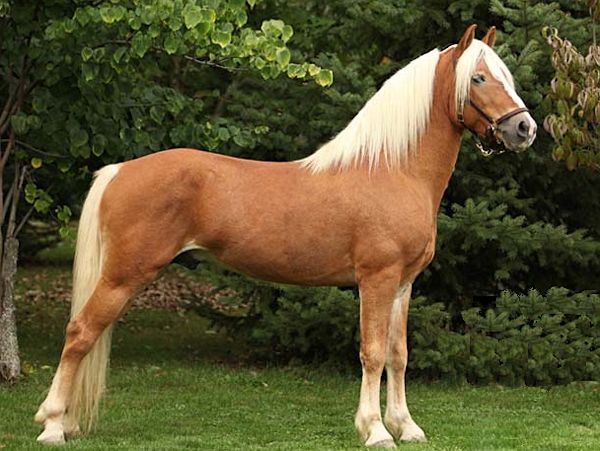
Their current conformation and appearance are the result of infusions of bloodlines from Arabian and various European breeds into the original native Tyrolean ponies. Also known as the Avelignese Pony Horse.
Origin: Haflingers are natives of Austria and Northern Italy. They descend from a race of mountain ponies that have grazed the Alps for centuries. The modern day Haflinger horse was developed around the 1870’s and got its name from the Tyrolean village Hafling, in Northern Italy. After World War II, the Austrian government started the routine breeding of Haflingers. These were first imported to the United States in 1958.
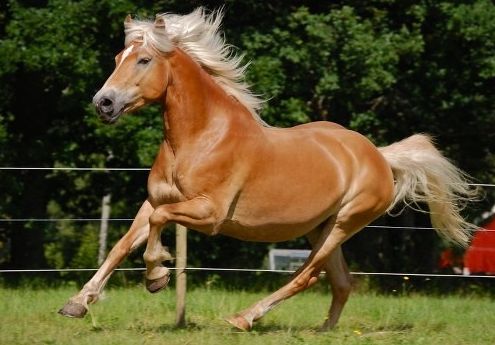
Color: Haflingers are always chestnut in color and come in shades ranging from a light gold to a rich golden chestnut or liver hue. The mane and tail are white or flaxen.
Height: Although it stands between 13 and 15 hands high, this horse is not a pony. The height of the breed has increased since the end of World War II, when it stood an average of 13.3 hands (55 inches, 140 cm). The desired height today is between 13.2 and 15 hands (54 and 60 inches, 137 and 152 cm). Breeders are discouraged from breeding horses under the minimum size, but taller individuals may pass inspection if they otherwise meet requirements of the breed registry.
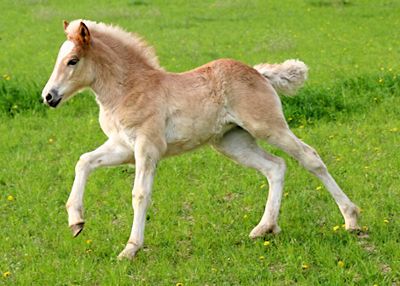
Conformation: Small head, crested neck, strong shoulders, broad long back, short strong legs. The chest is well muscled, broad and deep, and the limbs well defined. The overall appearance of a Haflinger horse is that of an athlete. They have distinctive gaits described as energetic but smooth. The walk is relaxed but energetic. The trot and canter are elastic, energetic, and athletic with a natural tendency to be light on the forehand and balanced. There is some knee action, and the canter has a very distinct motion forwards and upwards.
Some sources recognize two types of Haflinger, a shorter, heavier type used for draft work and a taller, lighter type used for pleasure riding, light driving and under-saddle competition.
The Food and Agriculture Organization recognizes both an “Avelignese” and an “Avelignese Tradizionale” as existing in Italy, although, as of 2007, only 13 of the latter existed, including only one breeding stallion. However, all breed organizations recognize and register only one type.
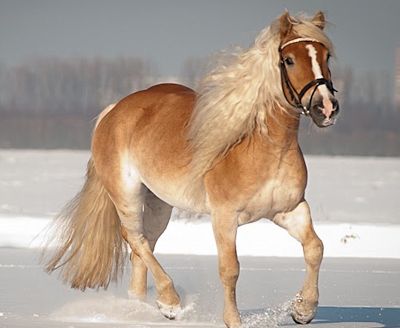
Character: The Haflinger is a very docile, gentle natured, and people oriented breed. Halflingers are very social horses and enjoy the company of other horses. They are intelligent and quick learners. They have a long history of living close to humans and, throughout the years, have developed an outgoing and engaging temperament.
A requirement for a quiet, kind nature has become part of official breed standards and is checked during official inspections.
Uses: They are multipurpose horses, and are superb driving horses, jumpers and successful in low to mid level dressage. They are also used for pulling farm equipment, therapeutic riding and of course trail riding and endurance. Cheerful and willing to work, these are horses for everyone; they are sturdy enough to carry a large adult and gentle enough to carry a timid child.
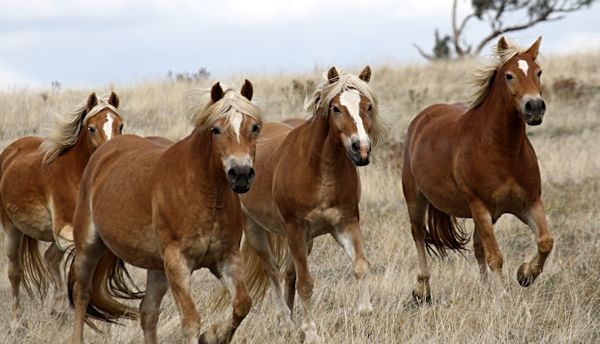
History: Origins of the breed are uncertain, but there are two main theories. The first is that Haflingers descend from horses abandoned in the Tyrolean valleys in central Europe by East Goths fleeing from Byzantine troops after the fall of Conza in 555 AD. These abandoned horses are believed to have been influenced by Oriental bloodlines and may help explain the Arabian physical characteristics seen in the Haflinger.
A type of light mountain pony was first recorded in the Etsch Valley in 1282, and was probably the ancestor of the modern Haflinger.
The second theory is that they descended from a stallion from the Kingdom of Burgundy sent to Margrave Louis of Brandenburg by his father, Louis IV, Holy Roman Emperor, when the Margrave married Princess Margarete Maultasch of the Tyrol in 1342.
It has also been suggested that they descend from the prehistoric Forest horse. Haflingers have close connections to the Noriker, a result of the overlapping geographic areas where the two breeds were developed. Whatever its origins, the breed developed in a mountainous climate and was well able to thrive in harsh conditions with minimal maintenance.
The breed as it is known today was officially established in the village of Hafling in the Etschlander Mountains, then located in Austria-Hungary.[19] The Arabian influence was strongly reinforced in the modern Haflinger by the introduction of the stallion El Bedavi, imported to Austria in the 19th century.
El-Bedavi’s half-Arabian great-grandson, El-Bedavi XXII, was bred at the Austro-Hungarian stud at Radautz[19] and was sire of the breed’s foundation stallion, 249 Folie, born in 1874 in the Vinschgau.[15] Folie’s dam was a native Tyrolean mare of refined type. All Haflingers today must trace their ancestry to Folie through one of seven stallion lines (A, B, M, N, S, ST, and W) to be considered purebred.
The small original gene pool, and the mountain environment in which most original members of the breed were raised, has resulted in a very fixed physical type and appearance.
In the early years of the breed’s development Oriental stallions such as Dahoman, Tajar and Gidran were also used as studs, but foals of these stallions lacked many key Haflinger traits and breeding to these sires was discontinued.
After the birth of Folie in 1874, several Austrian noblemen became interested in the breed and petitioned the government for support and direction of organized breeding procedures. It was 1899 before the Austrian government responded, deciding to support breeding programs through establishment of subsidies; high-quality Haflinger fillies were among those chosen for the government-subsidized breeding program.
Since then the best Haflinger fillies and colts have been chosen and selectively bred to maintain the breed’s quality. Horses not considered to meet quality standards were used by the army as pack animals.
By the end of the 19th century Haflingers were common in both South and North Tyrol, and stud farms had been established in Styria, Salzburg and Lower Austria.
In 1904, the Haflinger Breeders’ Cooperative was founded in Mölten, in South Tyrol, with the aim of improving breeding procedures, encouraging pure-breeding and establishing a studbook and stallion registry.
The foundation sire, 249 Folie, was born in 1874; by 1904 the first breeders’ cooperative was formed. All Haflingers can trace their lineage back to Folie through one of seven bloodlines.
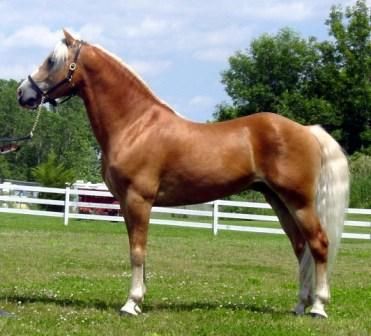
All Haflingers today trace their lineage through one of seven stallion lines to Folie, the foundation stallion of the breed. Usually, colts are given a name beginning with the letter or letters denoting their stallion line, and fillies are given a name beginning with the first letter of their dam’s name.
The exceptions are France, where foals are given a name beginning with a letter of the alphabet designated to be used for that year;and Italy, where colts’ names must begin with the letter or letters designating the stallion line, while fillies’ names begin with the letter designated for a given year.
The seven stallion lines are:
- A-line. Founded by Anselmo, born 1926. One of the most prevalent lines today, descendants include the second-largest number of stallions at stud. Anselmo was brought back to stud at the age of 21, when a lack of stallions after World War II led to concerns that the line would not survive, and produced several stallions now represented in all Haflinger breeding populations worldwide.
- B-line. Founded by Bolzano, born 1915. Bolzano’s less common line, although strong in Austria, is not prevalent elsewhere. The line is spreading nevertheless; the U.S. and several European countries including Great Britain are establishing Bolzano lines.
- M-line. Founded by Massimo, born 1927. An Italian stallion, Massimo founded a line that is prevalent in Austria and Italy.
- N-line. Founded by Nibbio, born 1920. Early in its history, the Nibbio line split into two branches, one in Italy and one in Austria. The N-line is populous, with the greatest number of stallions at stud. It is one of two (the other being the A-line) with a presence in all Haflinger breeding countries. The line is most prolific in Austria and Italy.
- S-line. Founded by Stelvio, born 1923. Stelvio is the least numerous of the lines, threatened with extinction after non-Haflinger blood was introduced in Germany. Currently most populous in Italy, Austrian authorities are working to re-establish it.
- ST-line. Founded by Student, born 1927. Although the ST-line has a large number of stallions, its geographic spread is limited because of unselective breeding in some countries. Germany and the U.S. hold the most horses of this line outside Austria.
- W-line. Founded by Willi, born 1921. The W-line, threatened by crossbreeding early in its history, maintains a strong presence in the Netherlands, Canada and the U.S., with a smaller population in Austria.
Bolzano and Willi were great-great grandsons of Folie, while the rest were great-great-great grandsons. Especially in the early years of the breed’s history, some inbreeding occurred, both by accident and design, which served to reinforce the breed’s dominant characteristics.
During the 1980s and 1990s, several studies were conducted to examine morphological differences among the breed lines. Significant differences were found in some characteristics, including height and proportions; these have been used to help achieve breeding objectives, especially in Italy during the 1990s.
World Wars I and II, as well as the Great Depression, had a detrimental effect on the breed, and lower-quality animals were used at times to save the breed from extinction.
During World War II, breeders focused on horses that were shorter and more draft-like, favored by the military for use as packhorses. The emphasis after the war shifted toward animals of increased refinement and height.
In the postwar era, the Haflinger was indiscriminately crossed with other breeds and some observers feared the breed was in renewed danger of extinction.
However, starting in 1946, breeders focused on producing purebred Haflingers and a closed stud book was created.
Interest in the breed increased in other countries and between 1950 and 1974 the population grew, even while the overall European horse population decreased. Population numbers continued to increase steadily and as of 2005, almost 250,000 Haflingers existed worldwide.
There are breeding farms in several countries, although most of the breeding stock still comes from Austria.
Although the Haflinger is now found all over the world, the majority of breeding stock still comes from Austria, where state studs own the stallions and carefully maintain the quality of the breed.
However, there are breeding farms located in the United States, Canada, Germany, the Netherlands, and England.
As of 2007, Italian Haflingers had the largest population of any breed in that country. Due to selective breeding during the 1990s aiming to increase height, some breed lines became favored over others in Italy.
A 2007 study found little inbreeding within the Italian Haflinger population as a whole, although certain less popular lines had a higher incidence due to the existence of fewer breeding stallions.
Haflingers are bred throughout France, especially in the provinces of Brittany, Burgundy and Picardy, with between 350 and 400 foals born each year.
Slovenia also has a small Haflinger population, with around 307 breeding mares and 30 breeding stallions as of 2008. A 2009 study found that although there was a very small amount of inbreeding in the population, it was increasing slightly over the years.[42] As of 2005 there were almost 250,000 Haflingers in the world
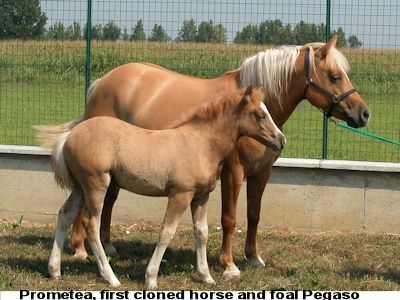
In 2003, a Haflinger became the first horse to be cloned, resulting in a filly named Prometea. Bred by Italian scientists, she was cloned from a mare skin cell, and was a healthy foal.
In 2008, Prometea herself gave birth to the first offspring of an equine clone, a colt named Pegaso sired by a Haflinger stallion through artificial insemination.
The American Haflinger Registry does not allow horses born as a result of cloning to be registered, although as of 2010 other nations’ registries have not yet entered a decision on the topic.
In January 2012, Breyer Horses created a model horse of the Haflinger.
